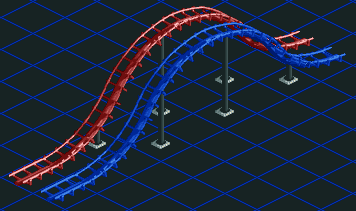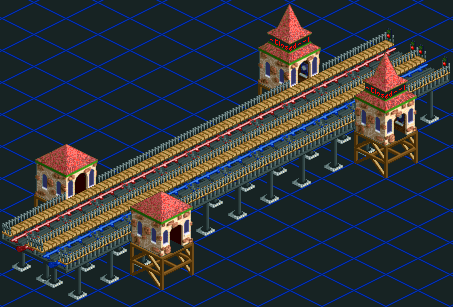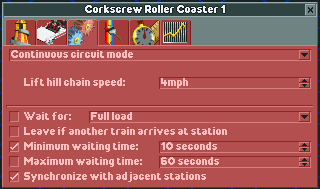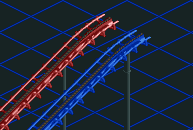The Parkmaker's Guide:
Duelers for Beginners
Sure, you can make a great roller coaster. Your roller coasters have high excitement ratings and weave in and out of excellent theming. In fact, you're the top notch pro at making an awesome coaster. But, are you coaster savvy enough to make awesome dueling coasters? Be careful. It's a whole new world when you're talking about duelers. You may not have the gift.
Well, just in case you don't have the gift, this tutorial will give you the basics about how to build and time dueling coasters just right. But first, test your Coaster IQ with this brief dueler's quiz. Look at the three pictures below, and analyze whether or not a coaster would take the same amount of time travelling both tracks. In other words, if you stuck a coaster on the red and blue track travelling the same speed at the same time, would they both reach the end together?
1.

2.

3.

How do you think you did? Are you ready for the answers? Alright then. All three of the tracks are equal. If the above pictures were apart of dueling coasters, the trains would remain synchronized and end at the same time. Why you ask? Let's break each picture down and analyze this question.
In the first picture, the two tracks are obviously of equal shape, size, and length. However, the second picture is not so clear. Is one shorter than the other? The answer is no. The method to finding this out is tallying up each track's sections. In the second picture, both the red and blue track has two straight sections, one small turn, and one medium turn. Therefore, they have an equal length. In the third picture, both tracks have two straight sections, and two large turns. They, too, have an equal length.
With that knowledge in place, we can begin creating our dueling coasters. The first thing builders often do is create the stations first. In order to synchronize the trains, you must first make sure that the two stations are adjacent to each other, like the picture below.

Now that you have your stations built, you might as well prepare both coasters for synchronization. To do this, left-click on one of the roller coasters. Select the tab that has two wheels at the top of the box and check "Synchronize with adjacent stations." left-click on the other roller coaster, and do the same as mentioned. If this is not done to BOTH roller coasters, they will not begin their circuit at the same time. Therefore, it would be impossible for them to be synchronized for the rest of the ride.

Alright, we're all set to begin the main part of our track. As always, begin with a lift hill. However, make sure that they are still side-by-side and end at the same point, somewhat like this:

You're on your own from there! However, keep this in mind: remember the quiz at the beginning of the tutorial? The best way to make sure your two coasters are synchronized is to tally their track sections. It's not as hard as it sounds if you do this as you go along. If Coaster A makes a small turn and Coaster B makes a medium turn, then make sure that Coaster A makes a medium turn and Coaster B makes a small turn eventually. That way, it balances out to be evenly timed.
However, the most important thing to remember when building duelers is to experiment. Try different turns, track elements, hills, or whatever you want. Have fun with it, and test it to see if it works. Yours doesn't have to be amazing or the best duelers around, all that's important now is to be able to have Coaster A and Coaster B timed equally. Once you make a few that are capable of doing that, you're ready to move on to becoming an Intermediate dueler. Good luck and keep building.
Copyright © Steve Welch